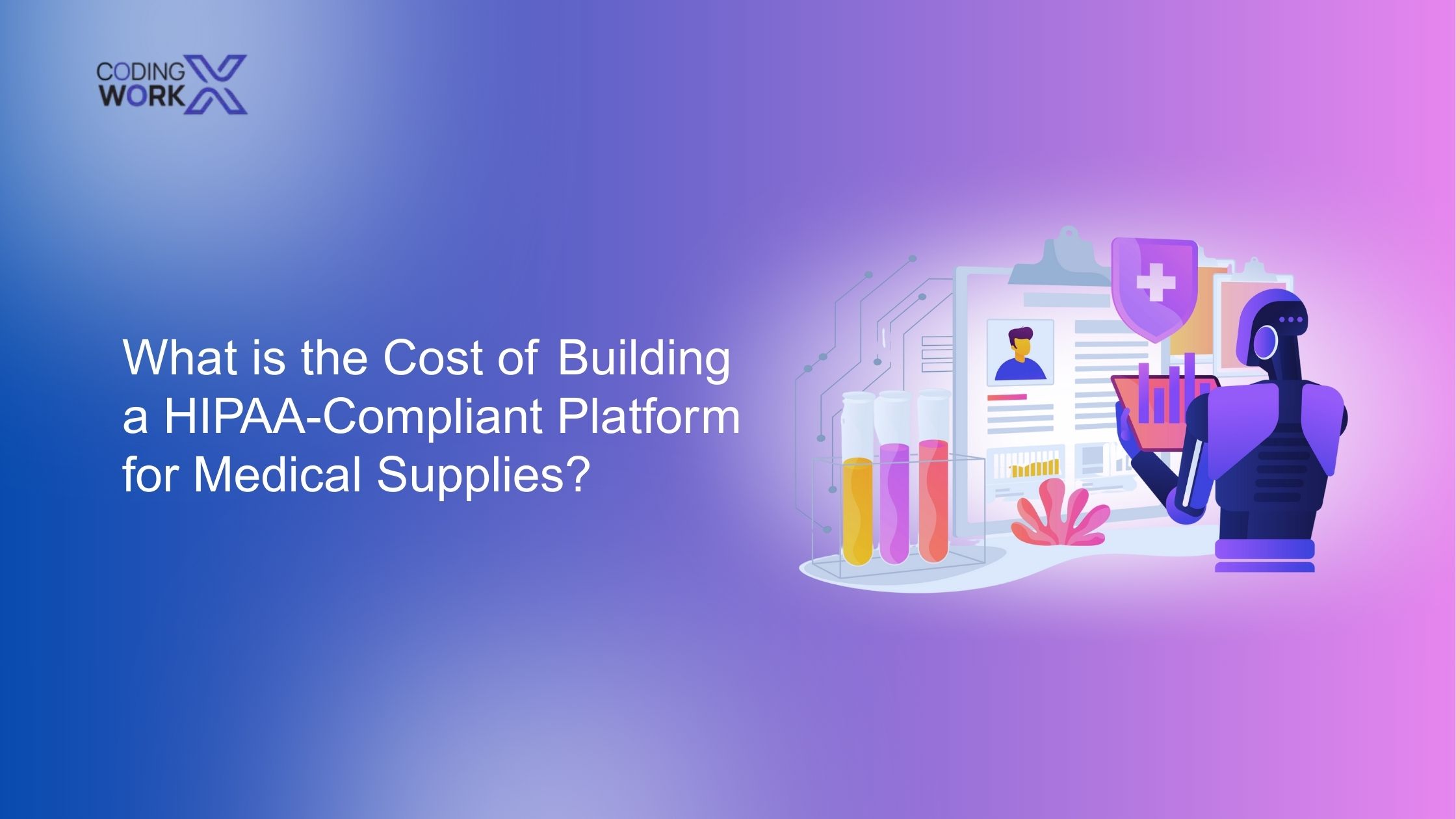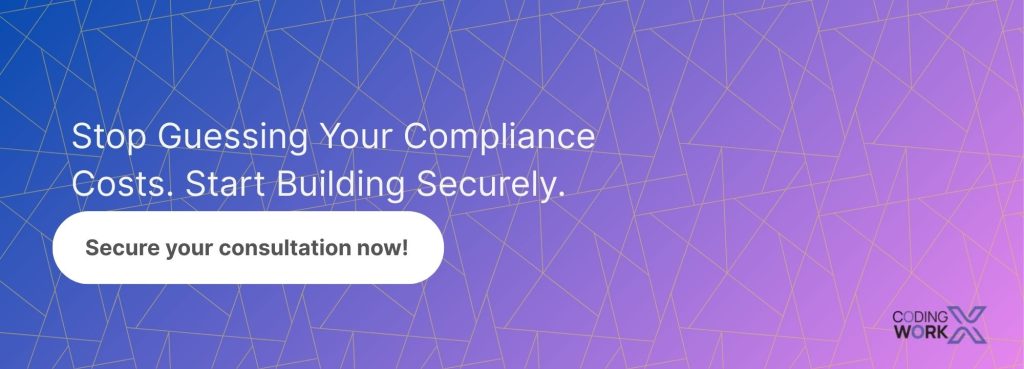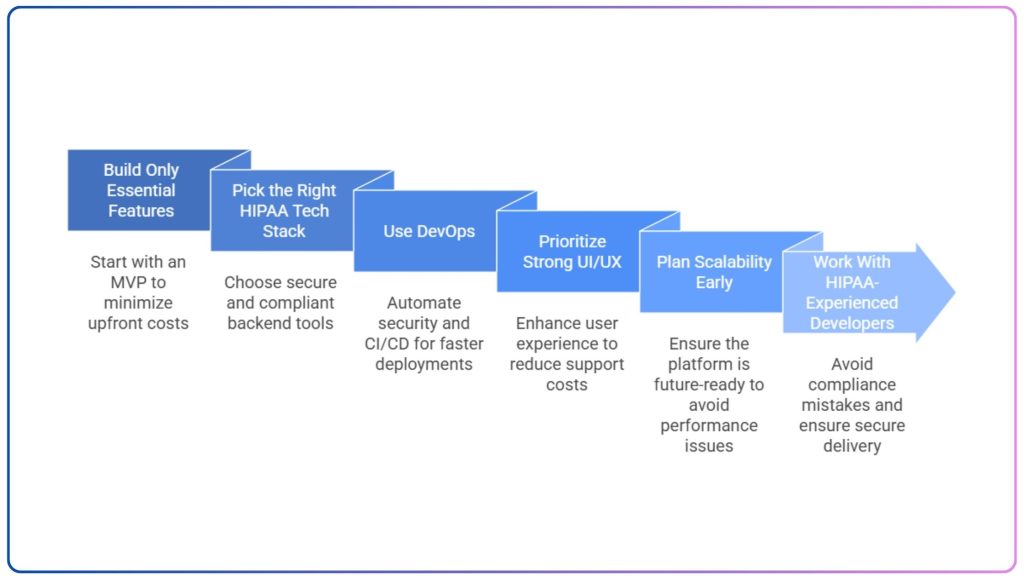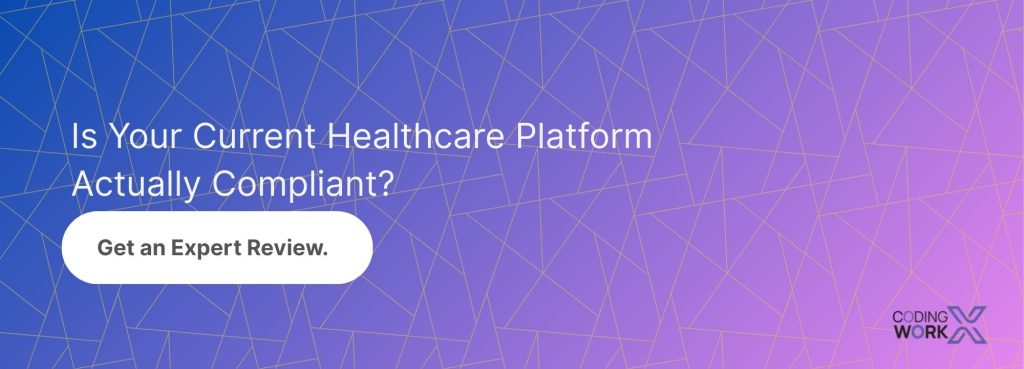
If you are thinking of building a HIPAA-compliant platform to manage, track, or deliver medical supplies, your core product is not just an app. Rather, it is the secure, auditable conduit for Protected Health Information (PHI). Ignoring the specialized requirements of HIPAA (Health Insurance Portability and Accountability Act) compliance will result in a budget overrun, project delays, and a lousy reputation in the healthcare industry.
Furthermore, as per Statista, the online pharmacy market is going to hit US$62.36bn by the end of 2025. Hence, it’s the right time for businesses to invest in HIPAA-compliant software development to get a competitive edge and boost ROI. However, healthcare software development for medical supplies requires extensive knowledge, experience, and huge investments.
So, it is important to plan the budget carefully, and on that note, keep reading this blog, as here we will walk you through everything about HIPAA-compliant app development, including features, factors, and others.
But before moving to the budget details, first understand why HIPAA compliance is mandatory for medical supplies.
Why is HIPAA Compliance Vital?
HIPAA compliance is a critical strategic differentiator and a mandatory prerequisite for any medical supplies platform seeking success in the high-stakes healthcare industry. It helps businesses protect their investment from crippling regulatory fines and breach costs, while simultaneously building the provider’s trust and data integrity required to secure high-value B2B partnerships and unlock lucrative, integrated patient service offerings.
In simple terms, compliance is the foundation upon which your HIPAA-compliant platform’s profitability and market access are built.
Why Medical Supplies Should Stick to the HIPAA Act
For medical supply businesses, investing in HIPAA-compliant software development is not just a regulatory chore. Instead, it is a strategic business imperative. And non-compliance can result in huge penalties, along with affecting your operations and customer trust.
- Protect Patient’s Privacy
Patient data like medical records, prescriptions, etc., are sensitive and valuable. Hence, it’s vital to make sure they are kept safe and protected while being transferred or stored. This prevents unauthorized internal access and drastically reduces the potential scope of a breach.
- Ensure Data Security
HIPAA compliance for healthcare software uses solid security measures like two-factor authentication, encryption, passwords, etc., to keep patients’ information secure, regardless of whether it is stored, moved, or delivered. This way, unauthorized persons or hackers can’t access patients’ confidential details.
- Regulatory Compliance
As per HIPAA regulations, healthcare businesses and their partners must follow a few rules to protect sensitive healthcare data. And when investing in HIPAA-compliant software development while following these rules, it shows that you are reliable and helps you avoid penalties and protect your reputation.
- Establish Trust and Reputation
When you build a HIPAA-compliant platform for medical supplies, it means you are taking patients’ privacy and data security seriously. This way, other healthcare providers, patients, and users trust you and consider you a trustworthy partner. And a data breach severely damages patient and provider loyalty, which directly impacts your bottom line.
- Competitive Edge
The healthcare industry includes strict laws and regulations, so developing HIPAA-compliant software for medical supplies makes you stand out from the crowd. This ultimately shows that you understand the specific requirements of healthcare providers and provide them with a secure platform.
Top Considerations for HIPAA-Compliant Software Development
Building a HIPAA-compliant platform for medical supplies is not just about adding security. Rather, it involves integrating regulatory adherence into the core of your medical supply app development. The following considerations are vital to avoid severe legal penalties, which can reach up to $50,000 per violation.
| Consideration Area | Key Requirements & Impact on Development |
| Data Classifications and Scope | It is vital to regularly identify and classify every data point that constitutes Protected Health Information (PHI) in the system (e.g., patient name, order details). |
| Mandatory Technical Safeguards | Implement Role-Based Access Control (RBAC), Unique User IDs, and Multi-Factor Authentication (MFA) for all users handling PHI. |
| Encryption (At Rest & In Transit) | In Transit: Use TLS/SSL (HTTPS) for all data communication. At Rest: Encrypt databases and backups where ePHI is stored (e.g., using AES-256). |
| Audit Controls and Logging | Your systems should automatically record and examine all activity related to ePHI. It is vital to detect breaches and investigate suspicious activities. |
| Mandatory Risk Assessment (SRA) | Conduct a comprehensive Security Risk Analysis (SRA) before launch and review it annually to find and document all vulnerabilities and threats to ePHI. |
| Data Backup and Disaster Recovery | Your healthcare software development company should implement a robust, automated backup system (encrypted backups) and a documented Disaster Recovery Plan (DRP) to restore ePHI quickly after a system failure. |
Steps Essential For HIPAA-Compliant App Development
Successful HIPAA-compliant software development is a structured and agile process centered on privacy and security. Each phase must integrate regulatory requirements to prevent errors later in the development cycle.
- Requirement Analysis
We start the development process with a detailed HIPAA compliance assessment and requirement analysis. This helps in identifying and implementing the right strategies and defining user roles and access levels according to HIPAA standards.
- Security and Privacy Measures Implementation
A reliable healthcare software development company like CodingWorkX prioritizes patients’ data security and privacy. So, this stage requires engineering a secure app architecture based on privacy-by-design principles. It includes the implementation of technical safeguards:
- Encryption
- Access control
- Firewalls and IDs
- Audit logs
- HIPAA-Compliant Framework
To make sure security protocols are both robust and objectively verifiable, the development team frequently aligns its processes with HIPAA compliance. This framework serves as a critical instruction book and enables developers to implement a mechanism, such as encryption, that can be technically validated and cross-referenced against all HIPAA Security Rule standards.

- Establish Secure Communication Channels
Having secure channels is a mandatory requirement for HIPAA-compliant software development. With encrypted messaging and file transfer protocols, a trusted healthcare software development company ensures safe transmission of sensitive patient data among different healthcare providers, suppliers, and patients.
- Testing & Quality Assurance
At this stage, your developers conduct thorough testing, which includes functional testing, security testing, usability testing, vulnerability scanning, and code review. This ultimately helps to find out and fix vulnerabilities or compliance issues.
- Continuous Support and Maintenance
Compliance is not a one-time project. Rather, it’s a continuous operational commitment. Ongoing support and maintenance help ensure that your HIPAA-compliant app is updated, flawless, and meets the industry standards. Also, any issues and security risks are addressed promptly.

10 Factors Influencing the Cost of HIPAA-Compliant App Development
The HIPAA-compliant app development cost is not a fixed price but a dynamic figure influenced by numerous technical, regulatory, and logistics factors. When it comes to building a HIPAA-compliant platform, it requires specialized knowledge and strict safeguards, which ultimately increases the total investment compared to a non-healthcare application.
- Software Complexity
It is the highest cost-driving factor of HIPAA-compliant software development. A simple platform with minimal features will cost you less than highly complex software with an extensive list of features. So, below is a rough cost estimation to build a HIPAA-compliant platform:
| Software Complexity | Estimated Development Cost | Time Established |
| Highly Complex | $130,000 to $200,000 | 10 to 12 months |
| Medium | $75,000 to $110,000 | 6 to 8 months |
| Simple | $50,000 to $70,000 | 3 to 6 months |
- UI/UX Design of Healthcare App
To offer a superior performance, designing an intuitive, clear, and error-minimizing interface, especially for clinical or complex workflow users, is vital. However, custom complaint design is more expensive than a template-based solution.
- Security and Compliance Requirements
Security and compliance are major things to consider while thinking of HIPAA-compliant app development. Implementing mandatory security measures like end-to-end encryption, automatic log-off, and audit controls to track all access and modifications to PHI can range somewhere between $30,000 and $74,000 for mid-range apps.
- Third-Party Integrations
Connecting your platform to external services is crucial but costly, as integration (EHR integration, payment gateways, logistics & inventory APIs) must also be HIPAA-compliant.
- Development Team Size
HIPAA-compliant software development requires more than just developers. While hiring freelancers can reduce the initial cost of development, there is a risk of malware and compromised quality due to a lack of expertise. On the other hand, hiring a renowned healthcare software development company can help you optimize costs while delivering top-notch quality with their specialized team.
- Development Team’s Location
The geographic location of your development team is one of the most variable factors, due to differences in hourly rates.
| Region | Typical Hourly Rates |
| North America (US/Canada) | $100–$250+ |
| Eastern Europe | $40–$100 |
| South Asia | $25–$75 |
Note: the costs given in the table are not accurate, as the final prices depend on your project’s scope and complexity.
- Device Compatibility
Building a HIPAA-compliant platform that runs on multiple operating systems (iOS and Android) or ensuring a responsive design across web, tablet, and mobile browsers can add to the development effort and cost.
Also, developing separate apps for iOS and Android offers the best performance, but it is more expensive than using cross-platform frameworks like Flutter, etc. It can save up to 40% in initial development costs but may sacrifice performance.
- Quality
Thorough quality assurance is mandatory in HIPAA-compliant app development, as the stakes are often higher. Also, testing helps ensure that your app for medical supplies works in optimal condition and stays updated and free of bugs. However, it can influence the overall development budget, as it requires more time and resources.
- Maintenance
Ongoing maintenance is a major, required investment for HIPAA compliance. The annual maintenance costs can add up to 25% of initial HIPAA-compliant platform costs per year. This includes regular security patches, upgrade features, compliance documentation, and adapting to new PHI regulations.
- No. of Features and Functionalities
Each feature that interacts with or displays data adds to the development time. The more roles (patients, providers, admin, warehouse manager) and the more complex the features, like multi-factor authentication, role-based access, and e-prescribing, the higher the cost will be.
HIPAA-Compliant Software Development Costs Based on Advanced Features
Foundational HIPAA compliance adds a baseline cost of roughly 20%-50% to your HIPAA-compliant app development. But the final spending is estimated by the complexity of the advanced features integrated.
So, the table below represents the estimated healthcare app development cost based on modern features.
| Advanced Feature | Estimated Development Costs |
| EHR Integration | $30,000–$150,000+ per EHR system |
| Secure In-App Messaging & Telehealth | $15,000–$45,000 |
| Advanced Multi-Factor Authentication (MFA) | $5,000 – $15,000 (Development) + ongoing $3–$5 per user/month (Licensing) |
| Role-Based Access Control (RBAC) Hierarchy | $10,000–$30,000 |
| Advanced Payment Gateway Integration | $15,000–$35,000 |
Estimating HIPAA Compliance Audit Cost: Factors Driving Your Investment
A HIPAA compliance audit is an essential step in validating your healthcare platform’s security and legal posture. This cost is driven by technical complexity, your organization’s preparation, culture, and environment.
Below is a breakdown of key organizational factors that influence the total investment required for a thorough and successful HIPAA compliance audit:
1. Your Organization Type
Different types of enterprises may have different levels of data handling and complexities, which influence the depth of audit required.
- Healthcare providers: need extensive audits due to complex PHI volume.
- Insurers: Face audits that focus on data management and security methods.
- Business associates: Audits are required to ensure compliance in managing PHI on behalf of other entities.
2. Your Organization’s Culture
A culture that prioritizes and documents compliance leads to clean, efficient audits.
- Compliance-Focused Culture: Results in smooth audits and lower costs.
- Less Mature Culture: higher costs and extensive remediations due to non-compliance.
3. Your Organization’s Environment
The complexity of your technical stack (infrastructure, systems, and coding practices) affects assessment time, which directly influences the HIPAA compliance audit costs.
- Modern, Well-Managed Environments: This results in lower audit costs due to better alignment with compliance requirements.
- Complex or Outdated Environments: Higher costs due to the requirement for more extensive assessment and remediation.
4. Your Dedicated HIPAA Workforce
The presence of a dedicated internal Compliance team ensures continuous readiness and organized documentation, resulting in lower audit costs. The lack of a dedicated team forces organizations to pay external auditors or consultants higher hourly rates for the time spent preparing and organizing basic evidence (policies, procedures, risk analyses).
How Much Does HIPAA-Compliant Software Development Cost?
As discussed earlier, giving an accurate healthcare app development cost is not possible, as it differs based on multiple elements. However, on average, building HIPAA-compliant software for medical supplies may range somewhere between $50,000 and $200,000.
Remember, the final cost to build a HIPAA-compliant platform may vary depending on the complexities and services it offers. So, it’s better to consult with a tech-forward healthcare software development company like CodingWorkX to get a detailed estimation as per your specific requirements.
Top Tips To Reduce the Cost of Medical Supply App Development
Building a top-notch HIPAA-compliant healthcare platform requires a significant investment; however, with some optimization tips, businesses can reduce the cost of healthcare app development without compromising quality. So, take a look at the strategies below from a top healthcare software development company:
- Focus on Essential Features
One of the most direct paths to cost control is launching a Minimum Viable Product (MVP). This approach limits the initial capital expenditure (CapEx) to an estimated $45,000–$90,000 over 3–6 months, compared to $250,000 or more for a full enterprise solution. Critically, this minimizes the scope of required quality assurance (QA), which can consume 30% to 45% of the budget for complex healthcare applications. Post-launch enhancements are then budgeted conservatively at $5,000 to $30,000.
- Choose Right HIPAA-Compliant Tech Stack
The backend and security layer is the largest single cost-driving factor and can range somewhere between $40,000 and $250,000. A trusted healthcare software development company can guide you on strategic selection and avoid a misfit technology stack. Remember to carefully examine all the available options and choose the one that fits your organization’s and compliance needs.
- DevOps Implementation
Implementing DevOps methodologies is an investment (costing $10,000 to $100,000) that delivers significant operational ROI. It enables the automated embedding of security and compliance checks through Continuous Integration/Continuous Delivery (CI/CD) pipelines. Quantifiable efficiency gains include drastic reductions in deployment time (e.g., from 27–35 hours to just 42 minutes in a case study) and improved incident response, ensuring continuous compliance and systematically mitigating the future cost of technical debt.

- Focus on Usability (UI/UX)
Poor usability is a hidden financial liability, costing organizations up to $4.7 million annually in lost productivity, increased support needs, and complex training. And optimizing the design reduces the legal risk associated with design-induced clinical errors and improves adherence and conversion rates by up to 200%.
- Plan for Scalability Earlier
The failure to plan for data flow and concurrency leads to expensive performance bottlenecks that are more expensive to fix later than addressing them during the initial development. This upfront planning ensures platform resilience and avoids costly retrofits during critical demand spikes.
- Collaborate with an Experienced Healthcare Software Development Company
Engaging a development partner with proven HIPAA expertise is vital for cost avoidance. While outsourcing can reduce initial costs by up to 50%, partnering with inexperienced developers who are unfamiliar with HIPAA regulations may necessitate expensive rebuilding or paying more later to fix fundamental compliance issues.
Monetization Strategies for HIPAA-Compliant Healthcare Software
An outstanding app without a clear monetization strategy is like a healthcare organization with no billing system, i.e., valuable but not sustainable. That’s why, for healthcare businesses, having the right model can make or break ROI. Also, your chosen model should fit your compliance requirements and patient expectations.

Below is a detailed comparison of monetization models.
| Approach | How It Works | Best Suited For |
| Subscription-Based | Users, whether patients or providers, pay a recurring fee to get access to the services. | Telemedicine platforms, chronic care apps, chatbots |
| Premium In-App Purchase | Core features are free, and users need to pay for premium features. | Fitness and wellness apps |
| Pay-Per-Use | Patients or providers pay per consultation, diagnostic scan, or any other service. | Telemedicine, diagnostics, RPM apps |
| Licensing and Partnerships | License AI tech for hospitals, insurers, or pharma businesses | AI diagnostics tools, predictive analysis |

Partner with CodingWorkX—Your Go-To Healthcare Software Development Company
As the HIPAA compliance transforms the healthcare market, organizations are partnering with top mobile app development companies to ensure their platform meets the industry standards and offers a secure experience. CodingWorkX is a reliable provider of healthcare app development services and has deep industry knowledge. We offer HIPAA-compliant services and build secure platforms for medical supplies.
Also, with our continuous support and maintenance services, we ensure your HIPAA-compliant software is updated, fully functional, and secure. Our extensive experience and industry know-how make us the ideal choice for HIPAA-compliant software development.
Contact our team to build your complaints and market-ready HIPAA-compliant platform.
In The End
Overall, the cost of HIPAA-compliant app development is not defined by one single element. Rather, it is dictated by risk mitigation, strategic feature complexity, and foundational security overhead. While the initial investment is higher than for a non-regulated app, viewing HIPAA adherence as a mandatory business framework—not an optional expense—is vital. Compliance shields your business from fines and builds trust and accountability, required to secure enterprise partnerships and scale seamlessly in the highly lucrative healthcare market. That’s why hiring a well-known healthcare software development company is vital to reduce the audit risks and ensure your delivery platform for medical supplies is a robust and market-ready asset.
FAQs
How much does it cost to build a HIPAA-compliant platform?
Well, the HIPAA-compliant software development cost differs. It is due to different factors like
- The number of features
- Functionalities
- UI/UX design
- Security and compliance requirements
- Integrations of APIs
- Development team size and country
- Maintenance
Are there any penalties for non-compliance with HIPAA?
Absolutely. It is vital to build a HIPAA-compliant platform, as not doing this will result in penalties and huge fines ranging from $100 to $55,000 for a single violation, along with a maximum annual penalty of $15 million.
How long does it take in HIPAA-compliant software development?
There is no accurate answer for this question. The actual time for HIPAA-compliant software development depends on project scope and complexity. Like, for example, a basic software with only essential features will take about 3 to 6 months. On the flip side, highly complex software with advanced features will take around 10 to 12 months.
How much does HIPAA Compliance Certification cost?
HIPAA certification costs can often vary for different organizations, small and large. The price starts from $10,000 and can reach up to $15,000. However, final certification costs depend on your business’s needs and complexities.
What types of datasets are required to train AI models in healthcare software?
Healthcare apps often deal with medical imaging, patient data, medical history, or ERH datasets. And data must be clean, anonymized, and diverse enough to eliminate bias in predictions.
